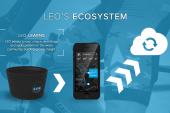
Movers and Starters is an exclusive series that profiles the individuals who drive Toronto’s startup community.
Tell us a bit about yourself and what you currently do.
I’m Avery, and I would say that I’m primarily a web designer; that’s the thing I’ve been doing the longest. I’m also the founder and lead-instructor of Camp Tech, which is one of the side projects that I’ve been running for the past year or so.
You were born in the United States, but have been living in Canada for the past several years. How did you find your way to Canada?
So I didn’t move directly from Florida to Toronto. I was born in Florida, and I lived all over the States while I was a kid, including Texas, Atlanta, and Chicago. When I was 13 I moved to Canada with my family, and I lived in Oakville until it was time to go to university.
Before becoming a web designer, you studied theatre production…
And I finished! I have a Bachelor of Fine Arts in Theatre Production…
Right, so what inspired your interest in theatre, and made you decide to try and pursue a career in the field?
As a kid, I was very interested in math and science. Had you asked me in grade nine what I wanted to be when I grew up, I would have probably said a mathematician. Then something happened around grade 11 or 12 where I became one of the drama kids. I’m not an actor, and I’ve never done any acting, but I found theatre production fascinating; there are a lot of different aspects of theatre production that are very scientific and mathematical, particularly lighting and sound design. And studying theatre production, I could both be creative, and be around the artistic people that I liked to hang out with. At the same time, the work was very methodical and logic based.
It sounds like had a successful career in theatre, but then at a very specific moment you decided to switch careers. Can you tell us about that moment?
I was 27 and burnt out.
I spent every summer while I was in university working for professional theatre companies. After I graduated I went to work for the Tarragon Theatre, one of the more well respected theatre companies in Toronto. While I was working full time, I would spend the day working for one theatre company, and at night I would go to work for a different company. So I definitely bit off way more than I could chew.
I loved my job, but it could also be exhausting. Obviously there’s an amazing community there, as well as amazing people, and I got to go to some of the best parties I’ve even been to while working in theatre. On the other hand, though, there’s very little money in theatre. You’re expected to work insanely long hours, and every project has extremely high expectations. It’s then that I realized that people that work in theatre for a lifetime work out a way to make it a lifestyle.
But in 2005, as some of the theatre companies were just beginning to bring their websites in house, I was the twenty-something kid that got to play with Dreamweaver and mess with my company’s website. Of course I had no idea what I was doing. I think at one point I deleted by accident the company’s website, but I was having fun. So I took some night school classes at George Brown in design and photoshop, and went from there. I was making up stuff as I went along, but I was having enough fun that I said to myself, “Wait a minute, maybe this is something I want to look into and pursue.”
I get the sense you decided to forgo agency work, and instead went to straight to freelancing. Any particular reasons you decided to skip agency work?
The reasons were two fold. I would love to say that the decision to skip agency work was well thought out. In reality, I didn’t go to a graphic design school like OCAD, and so I didn’t know anyone in that world. But I was also interested in freelancing from a lifestyle perspective, especially because I had burned out on theatre work while working for someone else; I didn’t want to go into a high demand profession working for someone else. So I decided to try freelancing and see how it went.
A lot of my first clients were theatre companies, because that’s the industry and community I came from. It’s a very small community and so the word got out.
What do you think it is about web design work that has sustained you for so long?
I think the fact that it is always changing excites me. That’s just the nature of the web, which is why I think a lot of graphic designers hate designing for the web, but that’s the exact reason I love it. There was maybe one day in October of 2009 when we had it all figured out. We knew how to build websites. We had HTML and CSS, and everything was cool. Then, all of a sudden, responsive design came out, and smartphones and tablets became a thing. It turned out that we didn’t know a thing, and to make things worse, we had to start to figure out how to make the Internet work on someone’s fridge (laughs). Some people find that overwhelming but I’ve always found it exciting.
I imagine that’s where Camp Tech came out of?
Yeah, so Camp Tech came directly out of my client services work. I decided that it made sense to start for a couple of reasons.
First, there’s been a rise in DIY options. For example, WordPress has gone from being a platform where you could host a simple blog to something where you can have an entire fully functioning website. And although WordPress is the main one, there are a lot of different ways people can build and maintain pretty nice looking websites without having a coding background. So that’s one of the things: technology has come to the point where you don’t need to have a design or coding background to build something.
At the same time, I started to see in my client work that people, especially women, felt intimated and scared by the Internet. They felt that making a website was something that was on their list of chores, and they would talk about it like they would talk about eating their vegetables. I said, “Wait a minute, building a website can be an enjoyable experience.”
It’s important that my clients don’t feel stupid. I think that part of the reason that a lot of women come to me for help with their websites is that I don’t make them feel intimidated or stupid.
Moreover, not everyone that comes to me can afford my services, or sometimes they want to try themselves. So before I even started Camp Tech, I was running a weekend workshop that focused on WordPress. I started to see these weekend workshops sell out and become widely successful. People also kept asking for more, and so it was right around this time last year that I started to think that there was a business model I could build around teaching people how to create their own websites.
Now, Camp Tech is completely different from programs like HackerYou and Bitmaker Labs. This is tech training for small business owners, entrepreneurs, and bloggers. It’s not for people that want to be professional developers down the road, and that’s the main distinction between Camp Tech and programs like HackerYou and Bitmaker Labs.
I went to this group of people that I already knew that included small business owners, entrepreneurs, and art organizations, and I asked them, “When it comes to the Internet, what do you want, and what do you need?” Some of them said to me, “I wish someone could give me a crash course on SEO (Search Engine Optimization). Everyone talks about SEO, but I have no idea what the hell it is.” Another example is that a lot of people know how to use Facebook and Twitter for their own personal use–so they know how to share pictures of their cat, their vacation, and they know how to tweet about the Oscars while they’re watching them–but a lot of people, especially small business owners, don’t have a social media strategy for their business. How you would use Facebook and Twitter for your business is different from how you would use it personally. So people were asking for these classes, and it just so happens that I have a lot of friends in the industry that agreed to help me teach them. So I put the workshops on sale, and they just started selling out.
Tina Roth EisenbergIn previous interviews, you’ve expressed your love for swissmiss. For those that don’t know who swissmiss is, want to tell us about her? And what is about her that you find so inspiring?
She’s obviously not the only person to inspire me, but she’s definitely among the top. Her real name is Tina Roth Eisenberg. Online, she goes by the name swissmiss–in part because she has a popular blog that is also called swissmiss. She lives in Brooklyn, and from what I’ve read of her personal story, she is from Switzerland. She moved to from Switzerland to New York City. She’s a graphic designer turned web designer, and she’s worked for a number of very prominent studios and agencies in New York. Eventually she started her own studio… It’s nice to see 30 and 40 somethings succeed in tech. It makes it so that I don’t feel like the dinosaur among all the 20 somethings. One of the main reasons that I love her is that, like me, she’s a mother in tech.
When swissmiss was pregnant with her first child, she decided to say no to client work; she did it as an experiment. “I’m going to take a year away from client work and just focus on my side projects and passion projects,” she said. Now her passion projects are her full-time gig. She has her blog, which gets millions of hits, she started a co-working space in Brooklyn called Studiomates–anyone that’s anyone in the web design community in New York works from her studio–she’s built a gorgeous iOS app called TeuxDeux, and she started a temporary tattoo company called Tattly.
Tattly is so interesting. Her daughter was five years old at the time, and so she kept taking her to kids’ birthday parties. Her daughter would come from these parties with a bunch of temporary tattoo, and as a designer, she was less than impressed with all the tattoos her daughter came home with. Tina says one of the best ways to complain about something is to try and make it better, so she started Tattly, which sells well-designed temporary tattoos for kids and adults. You can buy them at the Drake General Store–they are very hip. I mean it’s so cool that she doesn’t do anymore client work. She has a much better work-life balance in her life because of that.
One of the other things is that she is always positive. I follow her on Twitter. There’s a lot of ankle biting on Twitter, but I love that swissmiss doesn’t jump into the mud. When she has something to say, she will say it in a eloquent and intelligent way; she’s not the kind of person that will get on Twitter and start hating. Having had moments where I thought about getting on Twitter and blasting someone, I really admire that she doesn’t get involved in that kind of stuff.
How have you found the balance yourself?
It is really, really hard. I don’t claim to have it figured out. There’s all this talk about feminism, a woman’s work-life balance, and whether we can have it all. Sure, I think I have it all… sometimes. I’ve found it got a lot easier when my daughter started going to daycare full-time.
I don’t work with my child around. I can’t, because: one, my work would suffer; two, it wouldn’t be fair to her. I don’t think I would be a good mother if I tried to work at the same time I was supposed to be taking care of her, so I do have to limit my hours. Before I had a kid, I could stay up until 3am working away at a project. Now I can’t do that; I have to stop. She gets home from daycare at 4:45pm, and it doesn’t matter if I’m in the middle of the most epic coding session of my life, when she comes home, that’s it. I can pick it again when she goes to bed.
You know all this weird shit how people say that being a parent makes you a better person? Well, I know that having a toddler makes me a better designer. We often do arts and crafts, we sit around and play around with Play Dough. It’s really fun to sometime let your mind wander, and see what you can come up with when working with glue, pipe cleaners, and paint on the floor.
What are some things that motivate and inspire you outside of work? You’ve mentioned your husband as a source of inspiration in previous interviews.
Everyone is talking about this book that Sheryl Sandberg wrote called Lean In (Full title: Lean In: Women, Work, and the Will to Lead). It’s all about women in executive positions, and especially those that are in the tech world. She has a whole chapter that says one of the most important career decisions a woman can make is who they pick for a partner. You can imagine the outrage a statement like that caused. But in that chapter she says that one of the keys to her success has been that her husband also works in technology, and that he has been super supportive of her. In other words, they’re equal partners.
That has definitely been the case with me. I have a great husband. We share parenting tasks equally. While I’m spending all day Saturday teaching a class at Camp Tech, he’s looking after our daughter. I don’t worry that anything is going to going wrong. He’s not texting me every three minutes, asking me, “how do I do this? What do I do with her now?” That’s very important. I agree with Sheryl Sandberg on that front. Of course, I also know that’s not the only way to do things.
Of course I’m also motivated by deadlines. I also like to get out as much as I can. I’m very motivated by visual art and amazing theatre performances. I also like traveling and plugging in as much as I can with my industry. About a month ago I went to a conference in San Diego. I didn’t have a company paying for my trip, but it was important for me to go and see something new, and then go to a place where all the big names and thinkers in my space were speaking.
And because I’m a studio of one, it can be very lonely. I know some other studios of one in town, and we’ll often get together for a beer and a chance to shoot the shit. We’ll rant about our clients, about the challenges we’re facing, and we will even go into 45 minute long diatribes about what our favourite code editor is and why. Some seriously geeky stuff, in other words. But that kind of stuff feels good.
What’s next for you both professionally and personally.
Right now, I’m saying no to a lot of stuff, which is best feeling ever. I’m having fun saying no to projects that don’t interest me at the moment, which means I have more time to do some stuff that I actually love and have interest in.
We’re in private beta right now, so I can’t discuss this too much, but I’m working on a giant project for a new organization that is going to be based out of Massey College. It’s called the Art Canada Institute. The site for this group going to be amazing. We’re going to launch sometime in the fall, and it’s going to be all about Canadian art history. Not only do I love the tech side of what we’re building–it is sexy hot–but I also love the subject matter. I love that I’m doing this for a art organization and not a pharmateical company.
On a more personal front–and this is purely a side project–my husband and I are going to do a podcast together.
Can I be a guest?
Maybe. My husband is really into the craft brewing scene–he’s even an avid home brewer. Once a month, he turns our house into a brewery. He knows a lot of brewers in town that he’s friends with. He’s as much a beer nerd as I am a web nerd. So we have this kooky idea for a podcast. We have the equipment all set up, and we’re going to produce a podcast about craft brewing and web design, and how the two topics actually overlap. This is not to make any money, and we have no expectations that this will go anywhere. This is purely a fun passion project for the two of us to do.
____
Igor Bonifacic is a writer working for the Toronto Standard. You can follow him on twitter @igorbonifacic.
For more, follow us on Twitter @TorontoStandard and subscribe to our newsletter.














